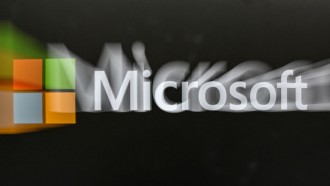
When someone tells us that the entire ecosystem of the internet is about to get turned on its head, we might be excused for thinking it's more hyperbole designed to get clicks. Not necessarily this time...
WEB 1.0
When the Web (WEB 1.0) arose, it was "a dark time for the Rebel Alliance"...because it was just starting to become interesting for the geekiest and nerdiest among us when Star Wars, Episode IV: A New Hope was just being released in 1977. We were using dial-up modems as slow as 160 baud, or 160 bits/second (go make a coffee), 300 baud which we could read as text filled the screen, and not fall behind, 1,200 baud (it took a fast reader to keep up), and then 2,400, 4,800, 9,600, 14,400, 28,800, 56K... Wow! Zoom! Yet it took quite a while for the general public to evince interest. The content was static, so there was nothing "exciting" to draw them in.
We used an FTP (File Transfer Protocol) program to request the file, receive it, and then we could read it with a text program of some kind. There still weren't Web Domains yet (1982) when a domain search engine arose called WHOis. That simplified life. By 1992 we had the first web robot that started to index the "Web". It became much easier to find documents we were searching for on this primitive internet. Basically, it was a bunch of hyperlinked documents that we could call (download) and read.
In terms of ordinary human users, it was preceded by BBSs (Bulletin Board Services) that posted data and created SIGs (Special Interest Groups) where we could write back and forth to other computer Gerds or Neeks. The most ambitious BBSs built wide-ranging, far-flung networks connected by dial-up modems that automatically called to update all the parallel BBSs and keep the messages in the SIGs aligned. There were no pictures, no tunes, and no programs. It was all text.
The real internet (per se) was largely colleges and universities sharing scientific documents, research papers, and weather data based on requests from other scientists. They used programs with peculiar names like ARCHIE and GOPHER. ARCHIE was the very first content search engine and was developed in Montreal, Canada. It wasn't named after the comic book character, but the search engines VERONICA and JUGHEAD, which were derived from the GOPHER search engine, were named after ARCHIE.
Eventually, web browsers were invented. Netscape was free, and we could download a copy (17 megabytes, a huge program in its day) in about six hours, so most people downloaded it overnight while sleeping.
WEB 2.0
This is everything we have now. This is where we gave up our privacy to use programs that were "free" in exchange for access to our personal information. This is where large corporations began investing heavily in information collecting, scraping, culling, organizing, and then selling. Information was the new currency, and what big companies knew about us was making them billions of dollars.
Products arose to limit how much information they could obtain, but the companies were too sophisticated; they knew our every move. They bought the software that was supposed to protect us, reverse engineered it, and found thousands of ways to circumvent it as they continued collecting our data.
Legislation evolved that restricted what they were allowed to do (and some obeyed it), but the profit potential was too high. They worked out ways that "weren't illegal yet" to continue collecting and selling our data.
The people of the European Union demanded effective laws, got them, and now every website has to ask our permission to put a cookie on our computer. But providers did it in the most obnoxious way possible where we can "ACCEPT" their cookie or go through a complex, convoluted, multifaceted list selecting which permissions they are allowed to exploit and which ones they cannot.
People got so fed up with it that they started to click "ACCEPT" all the time, defeating the purpose of the permission. Now there are apps like this one (for Firefox) that automatically accepts the cookies, so we don't have the massive window pop up on our screen preventing us from doing anything until we dismiss the box...
The advertisers, search-engine gurus, product-selling websites, and all the vested interests know precisely what they are doing. They're frustrating us, and they're still getting our information because we avoid the annoyance.
The invisible beacons on webpages report back to Facebook and Google every time we visit a page, and they continue to collect notes on which video we watched, what we clicked on, how long we looked at an item in a catalog, and all of our interests, just so they can sell that information.
They also record when we search for copper-bottom pots, abortion, sexually transmitted disease, Roe v. Wade, "insert political party here" queries, Amazon, Chromecast, cancer treatment, furniture, vacation resorts... They collect absolutely everything, giving them a list to sell to people, so they can tailor advertising to make us buy something from them.
WEB 3.0
The times, they be a'changin'
So far, over $237 billion has been invested in the new WEB 3.0 architecture. Will it knock Google, AMAZON, Twitter, and Facebook out of the top spots? Actually, it might! WEB 3.0 is all about decentralization, openness, and putting users back in control.
It's about getting rid of the middleman and letting people transact without all the delays, wastefulness, and costs associated with inefficient "gateways". If we can buy a $10 item from the creator for $10 plus shipping, that's a far cry from someone that bought it, warehoused it, marked it up, retailed it, leading to an eventual sale, and added shipping costs to deliver it for $73...
It's also about restoring privacy and giving users control over their data. It's about giving us digital ownership of our information so that no one can use it without our permission. We're entering the realm of blockchains and Non Fungible Tokens (NFTs).
Despite the recent meltdown in some cryptocurrencies, it still looks favorable for the long-term reorganization of our entire financial system. Decentralized Finance (De-Fi) generates a huge interest for folks who own crypto assets locked into the crypto-cycle to sustain the blockchain's functionality. They are "lending" their assets to allow people to trade with a fixed supply-and that makes them a lot of money. We can "make a living" by just doing that.
The Metaverse
No one can say how the Metaverse will evolve. Right now, it's focused on gaming (think "Ready Player One"), where we can compete for cash prizes against others, and NFTs, where artists and creators sell one-of-a-kind items for remarkable prices. It is definitely going to be more than it is right now.
It will allow different blockchains to connect with each other to complete transactions much faster and cheaper than current methods-but it will be even more secure. It will connect disparate servers so effectively that we may see the "one internet" realized where there is continuity in gaming, for instance, where there is no "load time" to enter a different server.
Dapps
These are programs that are attached to blockchains that anyone can use-that no one "owns"-and they will always reliably function in the same way. They can power gaming, social media platforms, financial applications, or just about anything we can imagine where the rules have to be fixed. Social Media cannot be censored; no one authority can alter the power of an investment; our privacy is completely protected and assured.
This happens because Dapps are made with "Smart Contracts" that are part of the blockchain, each carrying out its function. A single Dapp is Distributed (that's where the "D" comes from) across hundreds or thousands of computers, so it would be impossible to alter its function without agreement from the entire blockchain. It's impervious to hacking.
Security
The great thing about having Dapp code, or code of any kind, in public, attached to blockchains, is that anyone can look at it, but no one can alter it. Even if we can't code, a coder can attest that it does what it is supposed to do and doesn't steal data. This works the same way, such that if we can't trim a huge tree ourselves, we will call an arborist; we'll rely on experts to tell us that code is both safe and incorruptible.
Parsing
Web 3.0 will be able to understand our speech semantically. It won't be a matter of just a "set of words", but the intonation, emphasis, inflection, and the meaning of the meaning. Combined with our contemporary version of AI (Artificial Intelligence), which is currently just Deep Learning and Neural Networking emulating AI (not real AI by any stretch of the imagination), the ability of the system to interpret our intent should be magnificently accurate.
If we ask it to show us something-say vacation resorts in the Bahamas-then it will show us those, intuiting what we want based on previous activities. If we like it as an AR surrounding as we "walk through" the resort, that's what we'll get.
What we won't get is a stream of advertisements, related, unrelated, or otherwise, unless we ask for them. The source website will learn nothing about us that we don't tell them, and we won't get hundreds of targeted ads about the Bahamas the next time we check our e-mail.
Jacking In
Brain Machine Interfaces have been popular in SF for decades, including interfaces that look like a wired computer interface growing out of a skull. We've grown beyond that with the advent of Bluetooth and similar technologies.
Connecting directly still has some massive advantages, even if it is through an external device we have to carry, like a smartphone. Connecting directly to the brain poses some serious challenges, but since our eyes and ears are very good for transferring information, we can still do it successfully now.
Experiencing WEB 3.0
We speak of the IoT (Internet of Things) in a very casual way. Our phone can have a character in Google maps that will lead the way to our destination if desired. WEB 3.0 will take that a step further-no phone required.
Having a pair of Augmented Reality (AR) glasses currently lets us see virtual objects in our home that we can interact with directly simply by gesturing. We can see the room temperature, how much electricity our lamp has used when the window blinds are set to close automatically, and if we're running low on apple juice. It could even be an ever-evolving display of art we own as NFTs virtually projected on a blank wall.
But using AR, or even VR could be substantially improved by having nanotech contact lenses that do all that without necessitating glasses. They might even be semi-permanent (upgradable) lenses inside our eyes, like the Bionic Lenses used for extreme vision 3x better than 20/20. That and some earbuds, and we could be permanently connected.
Imagine walking into a party, and our (internal) eye lenses pop up people's names as we approach them, telling us their age, birthday, how many kids they have, their favorite color... Or walking down the street in our city's Chinatown and easily reading all the signs since they have our language superimposed on them.
This may sound amazing, but it only scratches the surface of what is possible. The future is not only better than we imagine-it is better than we can imagine.
There is no way to predict what amazing ideas will come to fruition. The one thing we can be sure of-it will be surprising.
* This is a contributed article and this content does not necessarily represent the views of techtimes.com





